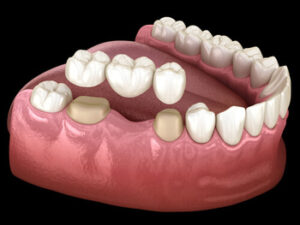If you’ve been living with a missing tooth or multiple missing teeth, you know how it can affect more than just your smile. It may impact your ability to chew, speak clearly, and even your self-esteem. Thankfully, modern dentistry offers a reliable solution: dental bridges. But what does the journey look like before and after getting a dental bridge?
Let’s take a closer look at the process, results, and what patients can typically expect whether you’re replacing one tooth or several with a porcelain bridge, implant supported bridge, or other types of bridges.
Why Replace Missing Teeth in the First Place?
Before diving into the procedure, it’s important to recognise why replacing missing teeth matters for both your oral health and overall well-being.
- Oral health: A missing tooth can cause shifting of other teeth, causing bite misalignment and increasing the risk of decay or gum disease.
- Aesthetics: Gaps in your front teeth can be especially noticeable, impacting your confidence.
- Function: Chewing and speaking properly become more difficult when back teeth or adjacent teeth are missing.
- Bone loss: Over time, the jawbone under a missing tooth can deteriorate, which is why options like dental implants or implant-supported bridges may be recommended.
Understanding the Different Types of Dental Bridges
Dental bridges are made to “bridge” the gap left by missing teeth, using artificial teeth anchored to natural teeth or dental implants. Here are the most common types:
- Traditional bridges: Use dental crowns on the abutment teeth (those on either side of the gap).
- Implant-supported bridges: These are anchored to dental implants instead of natural teeth, providing enhanced stability and support for the underlying bone.
Each type offers unique benefits and is recommended based on your oral condition, the location of the missing tooth, and your treatment goals.
Before: What to Expect During the Planning Stage
The planning stage is key to a successful dental bridge. Here’s what to expect before your new smile takes shape.
1. The Initial Consultation
Your dentist will start with a comprehensive exam, X-rays, and precise impressions of your teeth to assess the gap and the health of adjacent teeth and gums.
2. Choosing the Right Type of Bridge
Based on the number and position of your missing teeth, your dentist may suggest a traditional bridge or an implant-supported bridge. Factors like cost, function, and appearance all play a role in the decision.
3. Preparing the Abutment Teeth
With conventional bridges, the abutment teeth are gently reshaped by trimming a thin layer of enamel to allow space for the dental crowns that will support the bridge securely in position.
If you’re receiving an implant-supported option, the process includes implant placement surgery followed by a healing period to let the implant fuse with the bone.
4. Temporary Bridge Placement
While your new dental bridge is being custom-made in the dental lab, your dentist will place a temporary bridge to protect the prepared teeth and maintain the space.
After: The Results and Recovery
Once your dental bridge is placed, you’ll notice immediate changes in both function and appearance. Here’s what to expect during recovery and beyond.
 1. Receiving the Permanent Bridge
1. Receiving the Permanent Bridge
During your next visit, your dentist will take out the temporary bridge and assess the fit of your porcelain or metal-supported bridge. Once any necessary adjustments are made, it will be permanently cemented in place.
If you received an implant supported bridge, impressions would have been taken after implant integration, and the final bridge will be attached to the implants during this visit.
2. A Brand-New Smile
One of the most exciting parts of getting a dental bridge is seeing the transformation. The bridge blends in effortlessly with your natural teeth, restoring your smile’s overall look and functionality.
3. Adapting to the New Bite
It may take a few days to get used to the new dental bridge. You might experience slight sensitivity or discomfort, which usually resolves quickly. Your bite may feel different at first, but your dentist can make adjustments if needed.
Before and After Dental Bridge: A Real Difference
Here’s what typically changes when comparing the before and after dental bridge experience:
Before
- Noticeable gaps due to missing teeth
- Difficulty chewing certain foods
- Shifting of other teeth
- Uneven bite and pressure on surrounding teeth
- Risk of gum issues or decay
After
- Restored function and ability to eat comfortably
- Enhanced appearance, especially with porcelain bridges
- Even the distribution of bite pressure
- Prevention of adjacent tooth shifting
- Improved oral health and self-confidence
Caring for Your Dental Bridge
Proper care guarantees the longevity of your dental bridge. Here are a few simple steps:
- Brush and floss daily: Special flossing tools can help clean under the bridge.
- Use fluoride toothpaste: It helps protect the surrounding teeth from decay.
- Avoid very hard foods: This helps prevent wear or breakage, especially for porcelain options.
- Attend regular dental checkups: Your dentist will monitor your bridges and check your overall oral health.
With good oral care, crowns and bridges can last 10 years or more.
When to Consider a Dental Implant Instead
While dental bridges are highly effective, dental implants might be better in certain cases, particularly when the adjacent teeth are healthy and shouldn’t be crowned. An implant-supported bridge can also replace multiple teeth without involving natural teeth at all.
Final Thoughts: Bridging the Gap, One Smile at a Time
 Choosing to replace missing teeth with a dental bridge is a transformative step in your oral health journey. From that first consultation to seeing your confident smile in the mirror after placement, the changes can be both functional and emotional.
Choosing to replace missing teeth with a dental bridge is a transformative step in your oral health journey. From that first consultation to seeing your confident smile in the mirror after placement, the changes can be both functional and emotional.
Whether you decide on a traditional bridge or an implant-supported solution, the results are worth the journey. If you’ve been delaying treatment, take the first step and book a consultation with Maroondah Dental Care at 03 9007 2532. Your smile, health, and confidence will thank you.
Note: Any surgical or invasive procedure carries risks. Before proceeding, you should seek a second opinion from an appropriately qualified health practitioner.
References
- Mayo Clinic. (n.d.). Cavities/tooth decay. Retrieved from https://www.mayoclinic.org/diseases-conditions/cavities/symptoms-causes/syc-20352892
- Cleveland Clinic. (n.d.). Dental bridges. Retrieved from https://my.clevelandclinic.org/health/treatments/10921-dental-bridges
- Colgate. (n.d.). What is good oral hygiene? Retrieved from https://www.colgate.com/en-us/oral-health/adult-oral-care/what-is-good-oral-hygiene


 1. Receiving the Permanent Bridge
1. Receiving the Permanent Bridge
